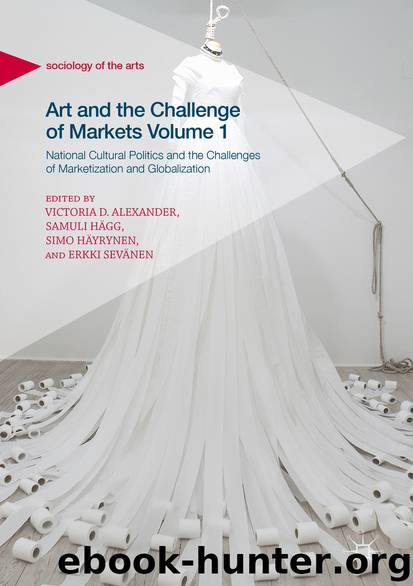Art and the Challenge of Markets Volume 1 by Victoria D. Alexander Samuli Hägg Simo Häyrynen & Erkki Sevänen

Author:Victoria D. Alexander, Samuli Hägg, Simo Häyrynen & Erkki Sevänen
Language: eng
Format: epub
Publisher: Springer International Publishing, Cham
Renegotiation of Cultural Welfare
A renegotiation of the postwar order started almost simultaneously in all of the Nordic countries at the end of the 1980s (Kananen 2011, 170). The collapse of the Soviet Union fundamentally changed the geopolitical position of Scandinavia and, in particular, Finland. Furthermore, unrestricted capital flows and neoliberal economic globalization undermined the economic sovereignty and capacity of an interventionist state. Conservatives of the Nordic countries argued that the labor market needed greater flexibility and more economic incentives (Einhorn and Logue 2003, 295–96, 306). Global economic competition caused pressures to cut taxation and public expenditures in view of competitiveness (Kautto 2001, 20–23). The new adjustment was explained by “the collapse of the paternalistic nature of the welfare state” (CP 1992, 233). Many analysts anticipated that the centralist model of the previous Nordic cultural policy would be replaced by much more consumerist, privatized, and fragmented models. Public cultural institutions, from the nationwide public broadcasting company to the municipal theaters, were expected to implement consumer sovereignty and self-financing. It seems that the cultural policy experts aimed at fulfilling the supposed expectations of the market toward the arts; artists themselves seemed incapable of this.
It is difficult to decide, though, if the development signified the end of the welfare state. Many reasoned that to increase market orientation in the arts is an absurd aim because Scandinavian countries have such narrow domestic markets for the arts (CP 1993b). Regardless of the intention of cultural policy to stress the private sector as the financier of cultural production, the promise of private finance has clearly been overestimated. The amount of sponsor money for the arts has steadily diminished since the “investment hysteria” of the 1980s (Oesch 2010, 88–89). Meanwhile, the absolute amount of public support for the arts and culture increased until 2013, and even its percentage of overall state expenditure increased, up to 2009 (Cultural Statistics 2014, 187–89). Thus, much more than a material change being in question is an ideological shift (cf. McGuigan 2004). In addition, the idea of a welfare state has been very popular among the populations of the Nordic countries (Schnyder and Jackson 2013, 323). Thus, it has been politically risky to criticize welfare state institutions.
None of these measures (flexible labor markets, privatization , outsourcing) rolled back the welfare state in any fundamental area. The normative legacy of the Nordic cultural policy has not disappeared. Yet, some of its basic elements have been reinterpreted. The political and economic agenda now emphasizes growth, productivity, and efficiency more than redistribution, equality, and security (Einhorn and Logue 2003, 328). The ideological shift has primarily been possible due to a strong maintenance of a political rhetoric about preserving old welfare state ideals. In order to avoid any blame that tough decision might incur, politicians have “outsourced” attacks on welfare state to consultants and the Ministry of Finance (Kananen 2011, 237–38). Traditional welfare state institutions, universities, and other cultural institutions have been modified to serve the new purposes of the competitive state .
Download
This site does not store any files on its server. We only index and link to content provided by other sites. Please contact the content providers to delete copyright contents if any and email us, we'll remove relevant links or contents immediately.
Things Are What You Make of Them: Life Advice for Creatives by Adam J. Kurtz(1776)
The Monuments Men by Robert M. Edsel(1702)
The Freelance Manifesto: A Field Guide for the Modern Motion Designer by Joey Korenman(1521)
Find Your Artistic Voice by Lisa Congdon(1347)
The Business of Being an Artist by Daniel Grant(1302)
101 Gag Ideas: Companion to the One Minute Caricature by James van der Keyl(1280)
Boom by Michael Shnayerson(1251)
Your Art Will Save Your Life by Beth Pickens(1203)
Your Inner Critic Is a Big Jerk by Danielle Krysa(1196)
Breakfast at Sotheby's(1163)
The Lady in Gold by Anne-marie O'connor(1154)
Seven Days in the Art World by Sarah Thornton(1142)
Create Your Art Career by Rhonda Schaller(1138)
How to Survive and Prosper as an Artist by Caroll Michels(1113)
When Talent Isn't Enough: Business Basics for the Creatively Inclined by Kristen Fischer(1074)
33 Artists in 3 Acts by Sarah Thornton(1070)
Need you Now (Top Shelf Romance Book 2) by unknow(1038)
Art Held Hostage by John Anderson(1032)
Art of the Deal by Noah Horowitz(1031)
